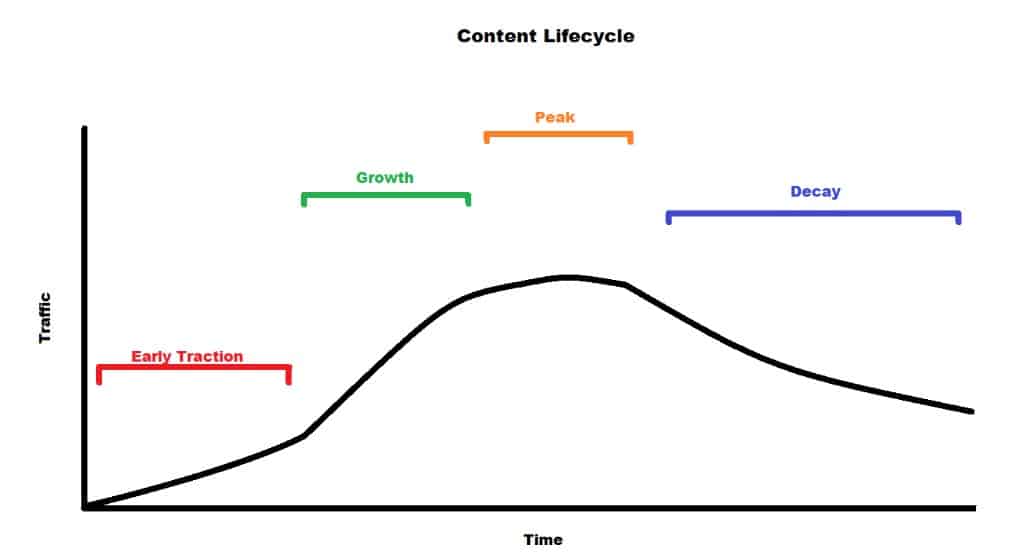Worried that your blog posts or articles aren’t attracting the visitors that they used to? This could point to content decay, and could be a sign that your target audience isn’t finding your website as easily as you’d like.
Don’t worry, though. Even if you are experiencing content decay, there are steps you can take to fix it. Read on to find out how.
Content decay refers to the gradual decline in traffic that a piece of content can experience over time.
If a piece of SEO content, such as a blog post, webinar, or white paper, was published 12 months ago and is no longer ranking highly on search engine results pages (SERPs) or is no longer generating organic traffic, it has experienced content decay.

Image created by the author
Causes of content decay
There are numerous potential causes of content decay that you should be aware of if tackling it is a key part of your content strategy. (By the way, if you’re struggling to hone your SEO strategy, checking out some SEO case studies might provide a few hints and tips).
Declining interest
Content pieces can drop in the search engine rankings simply because the keywords used aren’t as popular anymore. Shifts in consumer habits, as well as search intent, can contribute to this.
Rival content
The world of SEO is very competitive, and chances are there’ll be numerous other businesses churning out fresh content that targets the same keywords as yours. If your business rivals are producing more helpful, detailed, and relevant content, they can quickly usurp your place at the top of SERPs.
Keyword cannibalization
Creating multiple pieces of content focused on a target keyword must be the best way to move up the search rankings, right? Unfortunately not. In fact, having multiple blog posts that target the same keyword can split your search traffic and lead to lower rankings for all the pieces.
Outsource software development
Outsourcing software development tasks to external agencies or freelancers can sometimes result in content decay if not managed effectively. Content produced externally might not align perfectly with your brand’s voice or may lack the depth of understanding of your target audience, leading to less engaging content that decays faster over time.
Impacts of content decay
Let’s now find out some of the most harmful impacts of content decay on your content marketing strategy as a whole.
Reduced search visibility
The lower your content ranks on SERPs, the less likely it is that your target audience is going to find it. If all your content is experiencing decay, you’re going to receive a lot less organic traffic overall.

Image sourced from semrush.com
Lower click-through rate
If less people are seeing your content, it stands to reason that your click-through rate is going to drop too. This means that less people are finding your website through your content, which reduces the number of leads you’re generating, ultimately affecting your entire sales funnel.
Poor backlink performance
Content that has experienced decay is much less likely to generate backlinks. Other organizations won’t want to link to outdated or irrelevant content, and will instead link to content that ranks high in search results and matches search intent.
If you feel like backlinks are an area that you need some help with, an SEO and content marketing service like accelerate agency might be a good place to start.
4 tips for avoiding content decay
By now, it should be pretty clear that content decay can pose a problem for your SEO strategy. So how do you avoid it? Thankfully, there are a few different tricks you can try.
Each of these tips is easy to implement and certainly worth any time you put into it. But we appreciate time is a valuable resource. So don’t be afraid to outsource this as part of your wider SEO efforts. Reach out to agencies and ask for a content marketing proposal tailored to your needs and budget.
Refresh old content
Refreshing decayed content usually involves bringing it up to date to keep it relevant. For example, a piece titled ‘Technology Trends to Watch in 2020’ isn’t relevant in 2024.
By updating existing pieces of content like these with current dates, figures, and sources, you can ensure that older content remains timely and relevant, enabling it to still rank high on SERPs.
Refreshing old content is also an easy way of improving the website user experience. This could involve replacing broken links, optimizing image/video sizes and file formats for faster loading, and updating metadata to reflect current search intent.
User experience is yet another factor that search engines consider when ranking pages, so keeping it smooth and consistent can help your audience find your pages.

Image sourced from semrush.com
Prune underperforming content
Pruning content involves completely removing low-performing content. This is useful when you want to remove outdated or irrelevant content, for example where you’ve targeted a keyword that’s no longer relevant to your business due to a pivot in your overall strategy.
While content pruning isn’t likely to increase organic traffic as much as the other methods we’ve discussed, it can improve the performance of your website as a whole. It means that irrelevant or outdated content won’t drag down your scores in metrics such as average position or organic traffic.
Expand existing blog posts
Some content may still be strong and well-written, it’s just that fresh information or advancements in the subject matter mean that it’s lacking key information.
Expanding old blog posts is a great way to keep them relevant. You can use the additional word count to target new keywords that have become more relevant to the topic, or to insert additional information or up-to-date facts and figures to keep the piece authoritative.
For example, let’s say you wrote a blog on the best VPN deals but it only compares four providers. Looking at the top-performing buyers’ guides, you notice they all list around 10. Adding six more deals to your blog could be an easy way to expand the content while adding value for readers and bumping your article up the rankings.
Merge existing content
You can merge several existing pieces of content into one thorough, authoritative post. Not only does this prevent you from having to start from scratch in developing a new piece of content, but it’s also a great way to tackle the problem of content overload leading to decay.
Consolidating content allows you to prove to your audience and search engine crawlers that your post is the best possible source for any specific topic.
While combining two or more text posts is common, you can also merge multimedia content if you have it. For example, you could drop in a recorded webinar to a blog post on the same topic.
Be aware that merging content often requires some careful thought. For example, you want to avoid repeating sections in the new content, and you need to make sure that the piece still flows properly once the content is consolidated.
It’s also a good idea to check the internal links in any other pieces of content to ensure they link to the merged post rather than the old posts.
Boost your traffic by fighting content decay
Combating content decay is vital if you want to have a strongly performing SEO strategy.
Refreshing old content, pruning underperforming pieces, expanding existing guest posts, and merging content are all key strategies to rejuvenate the performance of your content.
These methods should not only enhance search visibility and click-through rates, but also improve user experience and backlink performance.
By proactively managing content, you can ensure your online presence remains relevant and competitive in an ever-evolving digital landscape.







